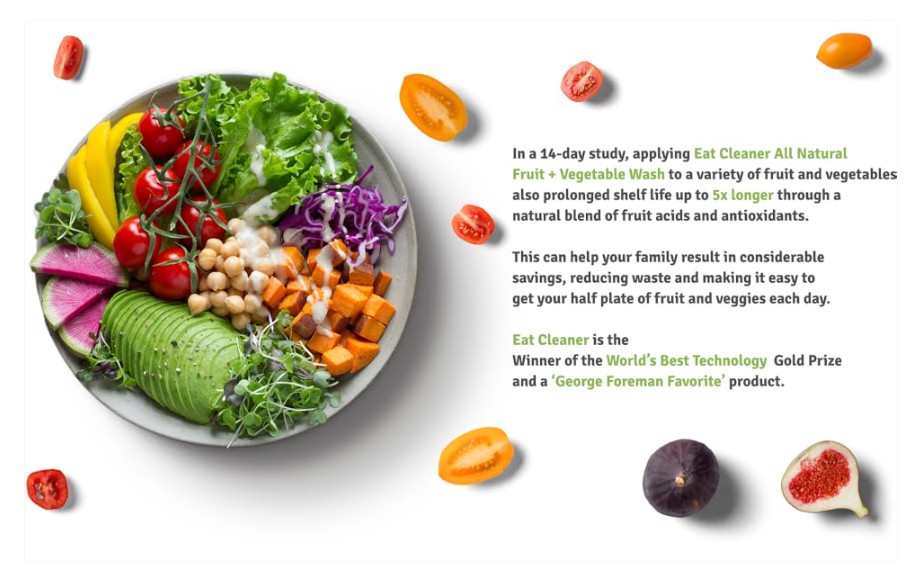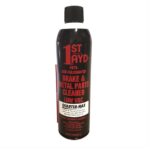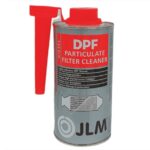In an era of heightened health consciousness, the phrase “eat cleaner ingredients” has become a guiding principle for many. From scrutinizing food labels to seeking out natural alternatives, consumers are increasingly aware that what they put into their bodies directly impacts their well-being. But with a dizzying array of products promising “clean” eating, how can you truly ensure your food is free from harmful residues and contaminants? This comprehensive article dives into the world of clean eating, with a particular focus on the Clean Boss Eat Cleaner product, exploring its ingredients, safety, and effectiveness, while also addressing broader concerns about toxic substances in our food supply.
Beyond the Rinse: Why “Clean” Matters for Your Produce
The journey to eat cleaner ingredients often begins at the grocery store, where fresh fruits and vegetables are staples of a healthy diet.1 However, even seemingly pristine produce can carry unwanted guests. Pesticides, waxes, dirt, and even bacteria can cling to surfaces, making a simple water rinse insufficient. This is where specialized produce washes, like Clean Boss Eat Cleaner spray, enter the picture.
The concern over toxic residues on produce is well-founded. According to the Environmental Working Group (EWG), a non-profit environmental organization, many conventionally grown fruits and vegetables contain detectable levels of pesticides.2 While regulatory bodies set “safe” limits, long-term exposure to a cocktail of these chemicals, especially for vulnerable populations, remains a point of contention. Beyond pesticides, some produce may be coated with waxes that can trap dirt and even contain petroleum-based components.3
Clean Boss Eat Cleaner: A Deep Dive into its Ingredients
Clean Boss Eat Cleaner presents itself as a solution to these concerns, offering an all-natural fruit and vegetable wash.4 To understand its claims, let’s examine the Eat Cleaner ingredients label. The product typically lists the following:
- USP Grade Purified Water: This is the base of the solution, ensuring a high level of purity.
- Citric Acid: A natural acid found in citrus fruits, commonly used as a food additive for flavor, preservation, and pH adjustment.5 It’s generally recognized as safe (GRAS) by regulatory bodies.
- Sodium Citrate: The sodium salt of citric acid, also a common food additive used as a preservative, emulsifier, and buffering agent.6 Like citric acid, it’s considered safe.
- Salt: A ubiquitous ingredient, used here likely for its mild abrasive and preservative properties.7
- Decyl Glucoside: A mild, non-ionic surfactant (a compound that lowers the surface tension of a liquid) derived from plants, typically corn starch and coconut oil.8 It’s biodegradable and commonly used in natural cleaning products and cosmetics. Its mild nature makes it suitable for food contact applications.
- Glycerin: A sugar alcohol derived from plant oils or animal fats.9 It’s a humectant, meaning it attracts and retains moisture. In this context, it might aid in the removal of residues. It’s widely used in food, pharmaceuticals, and cosmetics and is considered safe.
- Potassium Sorbate: A potassium salt of sorbic acid, commonly used as a food preservative to inhibit the growth of mold, yeast, and fungi.10 It’s generally recognized as safe (GRAS).
The company emphasizes that its formula is “patented, lab-proven, gluten-free, all-natural, and plant-based.”11 They also highlight certifications such as EPA Safer Choice Certified, USDA BioBased Certified (96%), and Hormone University “Endocrine Disruptor Free” Seal of Approval.12 These certifications suggest a commitment to using environmentally friendly and generally safe compounds.

Is Eat Cleaner Safe? Addressing Consumer Concerns
One of the most pressing questions for consumers is, “Is Eat Cleaner safe?” Based on the disclosed Eat Cleaner ingredients, the product appears to be composed of substances generally considered non-toxic and safe for food contact.
- Citric Acid, Sodium Citrate, Salt, Glycerin, and Potassium Sorbate are common food additives with well-established safety profiles.
- Decyl Glucoside is a mild, plant-derived surfactant that is biodegradable and generally well-tolerated.13
The key to its safety lies in the fact that it is designed to be rinsed off. While the ingredients themselves are not harmful if trace amounts remain, the product’s purpose is to remove contaminants, not to add anything new to your food that would be consumed in significant quantities. The company explicitly states that the product is “tasteless, odorless and colorless” and “leaves no aftertaste or odor.”14
Compared to cleaning produce with just water, which may leave behind more residues, or harsh chemical washes (which are rarely recommended for produce due to potential toxicity), Eat Cleaner offers a seemingly benign alternative.
Eat Cleaner Reviews Complaints: What Are People Saying?
To gain a holistic perspective on Clean Boss Eat Cleaner reviews, it’s important to consider both positive and negative feedback. On platforms like HSN and Walmart, a mix of opinions emerges.
Many positive Eat Cleaner reviews highlight:
- Effectiveness in cleaning: Users frequently report visible removal of dirt, wax, and other residues, leading to a sense of greater cleanliness.
- Extended shelf life: A recurring theme in positive Eat Cleaner reviews is the product’s ability to keep produce fresh for longer, with some users claiming up to 5 times longer.15 This benefit is significant for reducing food waste and saving money.
- Improved taste: Some users note that their produce tastes better after being washed with Eat Cleaner, suggesting the removal of unwanted films or residues.
- Ease of use: The spray-and-rinse application is often praised for its simplicity and convenience.
However, like any product, Eat Cleaner is not without its complaints. Some users have reported:
- Broken nozzles/packaging issues: A noticeable number of reviews complaints mention issues with the spray bottle nozzles being broken or the product leaking during shipment. While this doesn’t relate to the product’s efficacy or safety, it’s a frustration for consumers.
- Scent/aftertaste (less common for the produce wash): While the fruit and veggie wash is generally marketed as odorless and tasteless, some reviews of other Clean Boss products (like multi-surface cleaners) mention strong or unpleasant smells. It’s crucial to differentiate between product lines when evaluating scent complaints. For the fruit and veggie wash specifically, claims of aftertaste or strong smell are less prevalent but have been mentioned by a few users.
It’s important to note that many of the negative reviews found in general searches for “Clean Boss reviews complaints” often pertain to their other cleaning products (like the multi-surface disinfectant), which may contain different active ingredients (like thymol, which has a distinct odor). Therefore, when researching Clean Boss Eat Cleaner reviews, it’s vital to filter for feedback specifically about the fruit and vegetable wash.
Eat Cleaner Ingredients Reddit Discussions: Unfiltered Perspectives
For an even more raw and unfiltered look at consumer opinions, platforms like Reddit can be insightful. While specific, dedicated threads solely focused on “Eat Cleaner ingredients Reddit” may be less common, broader discussions on “cleaner eating,” food additives, and produce washes often touch upon products like Eat Cleaner.
General sentiments on Reddit regarding “cleaner” foods and ingredients often revolve around:
- Skepticism about marketing claims: Some Redditors express a healthy skepticism towards products that promise to “detox” or “cleanse,” preferring to rely on scientific evidence.
- Ingredient scrutiny: Users frequently delve into the individual components of products, discussing their known effects and potential concerns.
- Cost-benefit analysis: The price point of “cleaner” products is a frequent topic, with users debating whether the perceived benefits justify the higher cost, especially when compared to simple water rinsing or DIY solutions like vinegar.
- Effectiveness debate: While many appreciate the idea of removing pesticides, some question the true effectiveness of produce washes compared to thorough scrubbing with water alone.
When searching for “Eat Cleaner ingredients Reddit” or similar terms, you might find discussions where users share their personal experiences with the product, compare it to other washes or home remedies, and debate the scientific validity of its claims. These discussions can offer valuable qualitative insights, though they should be balanced with more formal scientific studies and product certifications.
The Broader Landscape: Avoiding Toxic Ingredients in Your Diet
Beyond produce washes, the concept of “eat cleaner ingredients” extends to all aspects of your diet. Consumers are increasingly wary of toxic additives, preservatives, artificial colors, and sweeteners found in processed foods.16 Organizations like the EWG provide valuable resources, such as their “Dirty Dozen Guide to Food Chemicals,” which highlights ingredients to avoid. Some commonly cited toxic or concerning ingredients in the broader food landscape include:
- Artificial Trans Fats: Largely banned in many countries due to their link to heart disease.17
- Artificial Food Dyes: Linked to behavioral issues in children.18
- Certain Preservatives (e.g., BHA, BHT, Sodium Nitrite): Some have been identified as possible carcinogens or endocrine disruptors.19
- Artificial Sweeteners (e.g., Aspartame): Debates continue regarding their long-term health effects.
- BPA and similar compounds: Chemicals found in food packaging that can mimic hormones.20
The movement to eat cleaner ingredients is about making informed choices. This involves:
- Reading food labels: Understanding the Eat Cleaner ingredients label on any product is crucial. Look for shorter ingredient lists with recognizable names.
- Prioritizing whole, unprocessed foods: The less processed a food is, the fewer additives it typically contains.
- Choosing organic when possible: While not a perfect solution, organic produce generally has lower pesticide residues.21
- Using effective cleaning methods for produce: Whether it’s a dedicated wash like Clean Boss Eat Cleaner spray or thorough scrubbing, ensure your fruits and vegetables are clean.
The Science Behind the Clean: Patents and Lab Testing
Clean Boss Eat Cleaner often cites its “patented, lab-proven” formula.22 Patents are granted for novel inventions, and in this case, a patent (US Government Patent 8,338,347, B2) exists for a fruit and vegetable wash formulation.23 This indicates a unique combination of ingredients and a specific intended function.
The claim of being “lab-proven to remove up to 99.9% of pesticides and chemicals” is a significant one. While the exact independent studies are not always readily available for public scrutiny on product pages, the company’s reliance on third-party testing and certifications (like EPA Safer Choice) lends credibility to these claims. These certifications typically require products to meet stringent health and environmental standards. The Wonder Cleaner: Your Ultimate Cleaning Solution – Reviews, Buying Guide & More
Final Thoughts: Making Informed Choices to Eat Cleaner
The desire to eat cleaner ingredients is a fundamental aspect of modern health. Products like Clean Boss Eat Cleaner offer a convenient way to address concerns about residues on produce.24 By understanding the Eat Cleaner ingredients, evaluating Eat Cleaner reviews complaints with discernment, and seeking out broader discussions (even on platforms like Reddit), consumers can make informed decisions.
Ultimately, a holistic approach to eating clean involves not only utilizing products that aid in food preparation but also a commitment to:
- Source food mindfully: Choose fresh, seasonal, and ideally locally grown produce.
- Minimize processed foods: Reduce reliance on items with long, unrecognizable ingredient lists.25
- Stay informed: Continuously educate yourself about food additives, potential contaminants, and best practices for food safety.
By embracing these principles, you can take significant steps toward truly eating cleaner ingredients and fostering a healthier lifestyle for yourself and your family.
External Resources for Further Reading:
- Environmental Working Group (EWG) “Dirty Dozen” and “Clean Fifteen” Lists: https://www.ewg.org/foodscores/
- Clean Boss Official Website: https://www.cleanboss.co/
- FDA Information on Food Additives: (You can search the FDA website for specific food additive regulations and GRAS status.)
- USDA BioPreferred Program: (For information on biobased certifications.)




